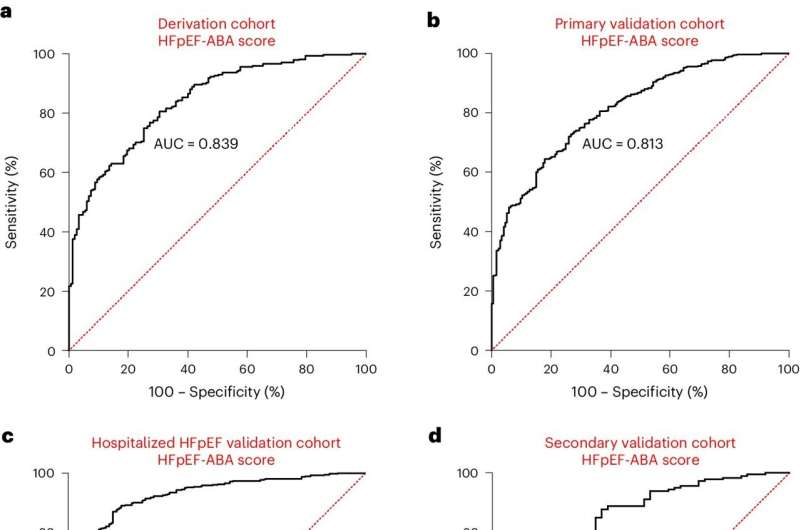This article has been reviewed according to Science X's editorial process and policies. Editors have highlighted the following attributes while ensuring the content's credibility:
fact-checked
peer-reviewed publication
trusted source
proofread
Researcher develops new score system to better screen and treat HFpEF heart failure patients

A novel study co-authored by a heart failure cardiologist at University Hospitals Harrington Heart & Vascular Institute demonstrates the effectiveness of a newly developed scoring system in identifying patients with Heart Failure with Preserved Ejection Fraction (HFpEF). The study, titled "An Evidence-Based Screening Tool for Heart Failure with Preserved Ejection Fraction: The HFpEF-ABA Score," was published in Nature Medicine.
In this research, Varun Sundaram, MD, Ph.D., MSc, FRCP (UK), also Associate Professor at Case Western Reserve University School of Medicine, and the Section Chief of Advanced Heart Failure at the Louis Stokes Cleveland Veteran Affairs Medical Center, along with heart failure investigators from Mayo Clinic, John's Hopkins, Medical University of South Carolina, Belgium, Japan, Denmark and Australia, developed the HFpEF-ABA score. It incorporates age, body mass index (BMI), and atrial fibrillation to aid in the diagnosis of HFpEF. This tool has the potential to revolutionize the diagnostic approach to HFpEF, particularly in patients with unexplained dyspnea, or shortness of breath, a major clinical issue.
With the new, simple scoring system, "We are able to screen and effectively identify patients with a high probability of HFpEF at the population level," says Dr. Sundaram. "We're tapping into an opportunity to elevate the standard of care, and it will change the paradigm for diagnosis for better identification of HFpEF at the community level."
The HFpEF score was derived and validated using data from large academic centers in Australia, Belgium, Denmark, Japan, the Netherlands, and the United States, including Johns Hopkins Medicine, the Medical University of South Carolina, Mayo Clinic and the VA, with the largest cohort being from the VA Medical Centers (n > 3,000).
Diagnosing HFpEF at the population level presents significant complexity and challenges, especially in a primary care setting, due to the multitude of variables involved in each patient's diagnosis. Many HFpEF patients remain undiagnosed for extended periods, often until their heart failure conditions have significantly progressed.
The newly developed HFpEF-ABA score model estimates the probability of HFpEF in individual patients based on three simple clinical variables: age, BMI, and atrial fibrillation. This model does not require sophisticated imaging for initial screening, making it accessible and practical for use in various health care settings, including primary care and rural areas.
Patients identified as having a high probability of HFpEF can then be referred for further imaging, such as echocardiography and cardiac catheterization if needed. Additionally, these patients can be initiated on newly approved drugs for HFpEF, including SGLT-2 inhibitors (SGLT-2i) and GLP-1 receptor agonists (GLP-1RA) in a timely manner, thereby improving their prognosis and long-term outcomes.
"We are very encouraged with the clinical implication of the study results," says Dr. Sundaram. Screening patients for HFpEF with the new scoring system "is something simple and quick that can easily be done by anyone in a primary care setting or urgent care."
In the United States, there are roughly six million heart failure patients, and that number is expected to reach eight million by 2030, driven largely by the increase in the elderly population, and by obesity. At least half of those patients will likely be diagnosed with HFpEF, the fastest growing type of heart failure, says Dr. Sundaram. The diagnosis and treatment of HFpEF is very different to other forms of heart failure, which makes early screening, diagnosis and treatment key, to avail patients of new and emerging therapies.
"By improving our ability to identify these patients, physicians can respond more quickly and effectively to treat their specific conditions," Dr. Sundaram states. "The new score was designed to address this need. It is a straightforward scoring model that has demonstrated excellent performance across diverse populations."
Dr. Sundaram and his team believe there is a significant proportion of the population that have undiagnosed HFpEF. Future research will focus on determining the best strategies to encourage clinicians to adopt the new HFpEF-ABA scoring system. This will help in identifying patients with a high probability of HFpEF and directing them towards appropriate clinical pathways for timely diagnosis and treatment, including newly available drug options.
More information: Yogesh N. V. Reddy et al, An evidence-based screening tool for heart failure with preserved ejection fraction: the HFpEF-ABA score, Nature Medicine (2024). DOI: 10.1038/s41591-024-03140-1




















